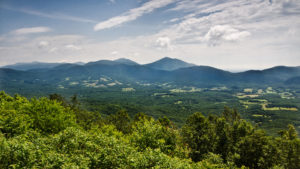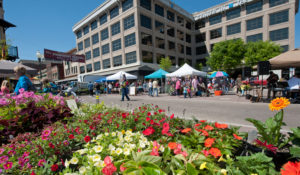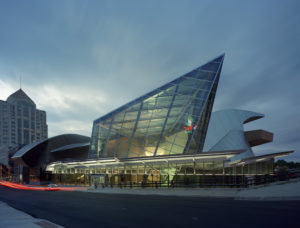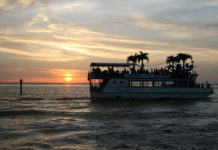
By Jeff and Ginny Orenstein
Note: The venues mentioned are open, some by appointment, but check before you go.
If you enjoy scenic valley, a mild temperate climate, beautiful mountains, abundant outdoor recreation opportunities, art and/or trains, you should put Roanoke, Virginia, and vicinity on your must-see list.
This appealing city of about 100,000 (about 325,000 in the region), set against the backdrop of the Blue Ridge Mountains, has all of that and more.
Located just west of the mountains on the Roanoke River, the geography that made the town a natural trade center has shaped its history. It became a significant railroad town in the 1880s, and today it has evolved as a major freight rail center that also celebrates its rail history with two excellent museums and an informative rail walk downtown. Roanoke also has a lot of urban appeal due to its emergence as western Virginia’s epicenter for business, education, tourism and health.
Virginia’s Blue Ridge is now open in Phase Three of the commonwealth’s Forward Virginia Recovery Plan in response to COVID-19. Most businesses are open, but occupancy is limited to 50% of capacity, or 1,000 patrons.

Before You Go:
Check these websites:
visitroanokeva.com/
facebook.com/RoanokeValley
virginia.org/cities/Roanoke/
downtownroanoke.org/
Getting There:
Roanoke can be easily reached by highway, air or train.
Roanoke-Blacksburg Regional Airport (ROA), six miles from the city center, is served by four airlines.
By train, there is Amtrak service to Roanoke. It is part of the Northeast Regional Route, making it easy to reach destinations like Lynchburg, Charlottesville and Washington, D.C. where connections to frequent East Coast trains can be made.
By car, Roanoke is on Interstate 81. It is 56 miles from Lynchburg, 100 miles from Greensboro, North Carolina, and 189 miles away from Richmond.
When You Are There for a Short Trip:
Explore the historic Roanoke City Market open daily.
Learn about Roanoke and railroads (and see some trains) along the 1/3-mile downtown David R. and Susan S. Goode Railwalk’s interpretive displays (temporarily located at the nearby Virginia Transportation Museum due to construction.)

If You Only Have Two or Three Days:
Must-sees for a short stay:
Visit the O. Winston Link Museum for some truly spectacular black-and-white rail photography by a master photographer from the steam era.
Tour the Virginia Museum of Transportation, home of restored steam locomotive N & W #611 and many other historical locomotives built at the Roanoke Shops. (vmt.org)
Visit the Taubman Museum of Art.
If You Have Several Days:
Kayak on the Upper James River Water Trail.

Take a drive on the Blue Ridge Parkway.
Hike a section of the Appalachian Trail or other Blue Ridge trails.
Visit Black Dog Salvage (as seen on the DIY Network), a 40,000-square-foot warehouse filled with antiques and commercial salvage items.
Participate in a Roanoke food tour (roanokefoodtours.com), once the temporary suspension is lifted.
Visit Natural Bridge Park.

Ginny O’s Tips for Dressing the Simply Smart Travel Way:
Since Roanoke is a regional business center with nice hotels, museums and some fine restaurants, the appropriate in-town dress should be a bit more formal than resort casual. Business casual that is appropriate for the weather is always in order.
For recreation in the surrounding Blue Ridge, though, typical activewear is the norm.
This Destination at a Glance:
Mobility level: Low for in town strolling and shopping, moderate to high for Blue Ridge explorations on foot, boat or mountain bike.
When to go: Anytime. Spring is gorgeous, summer is pleasant and fall color is incredible. Winters are cold but not severe.
Where to stay: The classy Hotel Roanoke downtown, or MainStay Suites Airport is also a good choice for proximity to restaurants, a mall and
the airport.
Senior advantage: There are museums and a great hotel.
Special travel interests: Mountain exploration, railroads and rail history
Jewish Roanoke
While Roanoke might not be a major Jewish center, the city is more Jewish than many small to mid-sized cities in this region.
The 2010 U.S. Religious Census: Religious Congregations & Membership Study published by the Association of Statisticians of American Religious Bodies indicated Roanoke had two of the nation’s 3,464 Jewish congregations — Beth Israel (Conservative) and Temple Emanuel (Reform). It also is home to a Jewish Community Council of Richmond branch and a Jewish Community Preschool, a joint effort of both congregations.
As the town grew in the 1880s, the first Jews arrived and soon created Beth Jacob congregation. Like many early congregations in the U.S., an influx of both western and eastern European immigrants eventually led to a split. In 1906, more traditional members left to start a new Conservative congregation, soon known as Beth Israel and the remaining members changed their name to Temple Emanuel.
During the boom years following World War II, Jews continued to settle in Roanoke. By 1960, there were 800 in town, although they were excluded from most social clubs and some other Roanoke organizations. The community dealt with typical antisemitism and exclusion prevalent in the U.S. at the time even though the civil rights era erased legal Jewish exclusion.
By the last fifth of the 20th century, Jews had become generally well-accepted — and active — in Roanoke’s social and civic milieu. There has been some evidence of antisemitism in Roanoke since an isolated act in 1988 and during the last few years, especially after the Charlottesville incident.
Today, the Jewish population of Roanoke is just over 1,000, and both Jewish congregations remain vibrant and active and are coping with the pandemic, When Temple Emanuel underwent major renovation, Beth Israel allowed the congregation to use its space for services. The temple maintains an active sisterhood, brotherhood, and youth group.
In 2013, Beth Israel had about 160 families. The synagogue’s sisterhood, men’s club and youth group host a number of different social and charitable events throughout the city. In 2005, the two congregations established the Jewish Community Preschool, which is open to all children in Roanoke. This communal effort is the latest in a long history of joint activities between the two congregations.
The Taubmans are a prominent Roanoke Jewish family and Advance Auto Parts, founded by Arthur Taubman in 1932, is Roanoke’s lone Fortune 500 company. Nick Taubman served as U.S. ambassador to Romania from 2005-’08. The family has been influential in Roanoke’s arts community and, in 2008, it made a large donation to what is now known as the Taubman Museum of Art in downtown Roanoke.
Jeff and Ginny Orenstein are travel writers from Sarasota, Florida.






